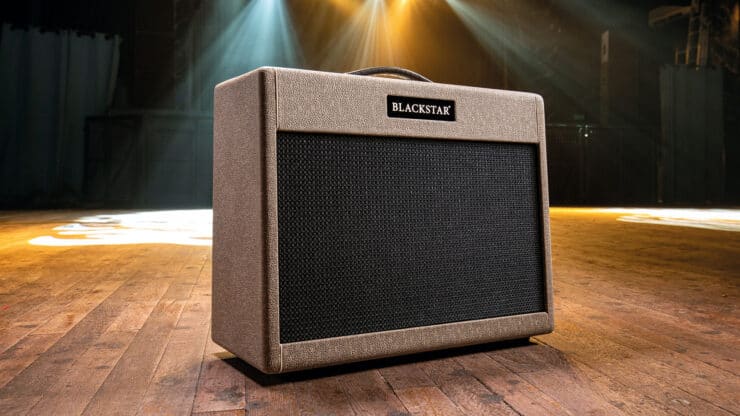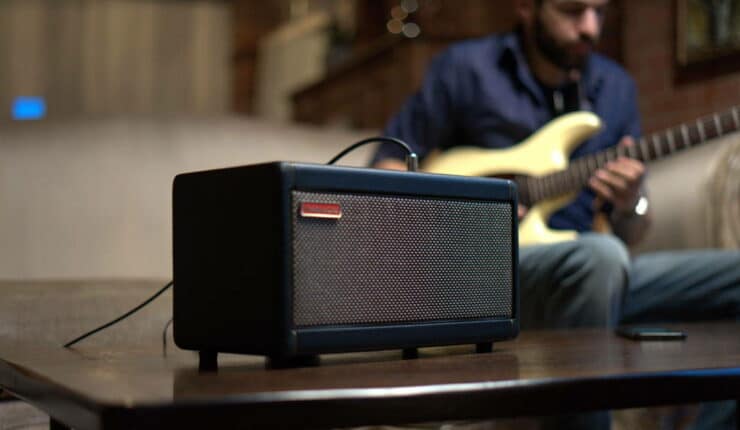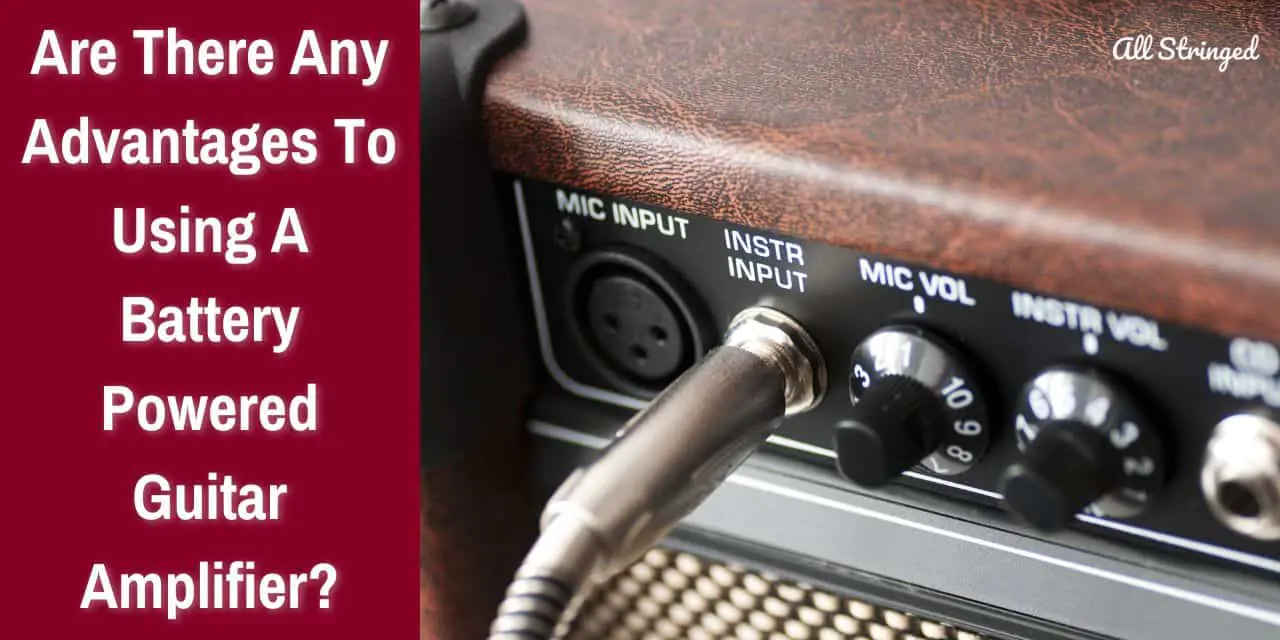Are you a guitar player looking for the next step in your musical journey? Do you want to know the advantages of using a battery powered guitar amplifier? If so, then you have come to the right place! In this article, we will discuss the benefits of using a battery powered guitar amplifier and why more and more guitarists are opting for this type of amplifier. So, if you are looking for a new sound for your guitar playing, read on to find out more about the advantages of a battery powered guitar amplifier.
What are battery-powered guitar amplifiers?
For musicians and guitarists, it is important to not only find the perfect tone but also have the freedom to play anywhere. Thanks to the introduction of battery-powered guitar amplifiers, musicians have now found a solution that perfectly combines the best of portability and versatility, allowing them to unleash their musical creativity on the go. These amps have become a game changer for musicians and guitarists, allowing them to unleash their musical talents anytime, anywhere.
>>> Click here to read our review about the Top 15 Best Battery Powered Guitar Amps <<<
Battery-powered guitar amps are compact and portable amps designed specifically for guitar players. Unlike traditional guitar amps that require a power outlet, battery-powered guitar amps run on batteries. This makes them perfect for musicians who want to play without being tethered to a power source. These amps come in different shapes and sizes, ranging from small practice amps to more robust models that are ideal for small gigs and performances.
Here are the different types of battery-powered guitar amplifiers in the market –
#1. Battery-powered practice amps
Battery-powered practice amps are the most compact and lightweight among different types of amps. Designed for individual practice sessions, they usually feature lower power output and are intended for personal use. These guitar amps are perfect for guitarists who wish to practice quietly at home or on the go, without disturbing others. They often come with headphone jacks, which allow for silent practice, with some models also incorporating built-in effects to inspire experimentation and creativity.

#2. Battery-powered mini amps
Mini amps are slightly bigger than practice amps and offer more power and versatility. They are perfect for musicians who want a portable amp with a bit more volume for small jam sessions, impromptu performances, or playing outdoors. Battery-powered mini amps often include tone-shaping controls and built-in effects, providing a range of sounds to explore. Despite their small size, they can pack a punch and deliver an impressive tone for their compact form factor. Brands like Boss, Vox, etc. have an impressive range of battery-powered mini amps to allow you to practice and record.
#3. Battery-powered combo amps
Battery-powered combo amps are more substantial and powerful, combining both an amp and speaker in a single unit. These amps are ideal for small gigs, rehearsals, and performances in intimate settings. They offer more headroom and can project sound much better than practice or mini amps, making them a particular favorite option for musicians who need a versatile amp for various occasions. Some battery-powered combo amps also come with additional features like multiple channels, onboard effects, and connectivity options.
#4. Battery-powered amp heads
Battery-powered amp heads are separate amp units without built-in speakers. They are designed to be paired with external speaker cabinets, offering a higher degree of customization and flexibility. Amp heads are typically favored by musicians and guitarists who want to create their own personalized rig and experiment with different speaker configurations. These battery-powered guitar amp heads offer ample power for medium-sized venues and offer extensive control over tone and sound.
#5. Battery-powered modeling amps
Modeling amps are extremely versatile amps that are capable of simulating the sounds of various classic and modern amps as well as different effects pedals. These amps combine the convenience of portability with a wide array of tones and effects.
Battery-powered modeling amps typically include multiple amp models, digital effects, and onboard presets. This allows musicians and guitarists to switch between different sounds seamlessly. This makes them excellent choices for musicians looking for versatility and sonic exploration.
#6. Battery-powered tube amps
While extremely rare, there are some battery-powered guitar amps that make use of tube technology for achieving their tone. Tube amps are known for their warm and natural sound and battery-powered versions offer guitarists the opportunity to enjoy the classic tone without being tied to a power outlet. These amps are favored by musicians and guitarists who appreciate the unique characteristics of tube-driven sound and wish to experience it in a portable package.
Are there any advantages to using a battery powered guitar amplifier?
For musicians and guitarists, the world is their stage, and the quest for musical expression knows no boundaries. With the introduction of battery-powered guitar amps, musicians have been unshackled from the limitations of traditional amps, enjoying newfound freedom and versatility. If you’re wondering are there any advantages to using a battery powered guitar amplifier, then you will be glad to know that the answer is yes.
These portable wonders have become a valuable tool for guitarists, offering a whole host of advantages that elevate their playing experience to new heights. These amps are known for their portability, energy efficiency, and freedom to practice anywhere. They’re also celebrated for their versatility, offering an impressive range of sounds and effects. However, that’s not it as there are many other advantages as well that these amps bring to the table. Here are some of the biggest advantages that are offered by battery-powered guitar amplifiers and how they’ll help you with the way you practice, perform, and connect with your craft.

Portability
The most obvious and biggest advantage of a battery-powered guitar amp is the portability and mobility these amps offer. With no reliance on power outlets or cables, guitarists can take their music wherever they go.
Whether you are taking part in a beachside jam session, an outdoor gig, a spontaneous rehearsal in the park, or a road trip, battery-powered guitar amps will empower you to share your music in any setting. The lightweight and compact design makes them quite easy to carry, opening up a world of opportunities when on the move.
Freedom to practice anytime, anywhere
Battery-powered guitar amps offer the freedom to practice anytime, anywhere. You will no longer be confined to a dedicated practice space or studio. This will allow you to unleash your creativity whenever inspiration strikes. Whether it is early morning practice in the backyard, a short break when at work, or late-night noodling on the porch, battery-powered guitar amps allow for uninterrupted practice sessions without disturbing others.
Versatility in performance
Battery-powered guitar amps aren’t just limited to personal practice, they also excel in performance settings. Many models come with built-in effects, tone-shaping controls, and multiple channels, offering a broad range of sonic possibilities. Musicians and guitarists can switch between clean tones, crunchy distortion, and ambient reverb on the fly, adjusting their sound to suit different genres and performance venues.
Backup amp for onstage reliability
For gigging musicians, battery-powered guitar amps serve as reliable backup options. In case of power outages, technical issues, or limited electrical access at a venue, these amps can step in to ensure a seamless performance. Their portability and easy setup will make them a lifesaver in unexpected situations, allowing the show to go on without a hitch.
Energy-efficient and environmentally friendly
Battery-powered guitar amps are designed to be energy-efficient, which makes them environmentally friendly options. They draw less power, which not only extends battery life but also reduces overall energy consumption.
This eco-conscious approach aligns with the growing trend of musicians looking for sustainable and responsible choices in their equipment.
Ideal for street performances and buskers
Street musicians and buskers can benefit greatly from battery-powered guitar amps. They offer amplified sound without the need for power outlets, which makes it easy for musicians to share their talents with passersby in urban centers, parks, and public spaces. Battery-powered guitar amps bring a professional touch to street performances and attract more listeners.
Reduce cable clutter and setup time
Battery-powered guitar amps simplify the setup process by eliminating the need for power cables and extra connections. This reduction in cable clutter will not only create a cleaner and more organized stage or practice space but also streamlines the setup time greatly. Musicians can focus on their performances and less on cable management, ensuring a smoother and more efficient practice or gig experience.
Deliver a more intimate performance
Battery-powered guitar amplifiers often have lower wattage compared to mains-powered amps, making them ideal for intimate and small-scale performances. These amps allow guitarists to connect more intimately with their audience as they can control the volume more effectively in smaller venues or acoustic settings. This results in a more personalized and engaging performance that resonates with listeners on a deeper and more intimate level.
Ideal for silent practice with external speakers
Battery-powered guitar amplifiers can be connected to external speakers or headphones, which makes them perfect for silent practice sessions. This feature is especially useful in shared living spaces, dormitories, or late-night practice when guitarists have to keep the noise down. Silent practice allows musicians and guitarists to focus on technique, improvisation, and experimenting with different sounds without disturbing others.
Perfect for recording music on the go
Battery-powered guitar amps are a boon for musicians recording music on the go or in unconventional settings. With their compact design and portability, these amps can accompany musicians to outdoor recording sessions, remote locations, or makeshift studios. They offer a reliable and consistent amplification solution for recording acoustic or electric guitar tracks even in challenging recording environments.

Cost-effective and budget-friendly
Battery-powered guitar amplifiers can be a highly cost-effective solution for musicians, especially the ones who are just starting out or on a budget. They typically have a lower price point compared to high-end mains-powered amps, making them easily accessible to a broader range of musicians. The lower wattage and power requirements also contribute to a reduction in operational costs over time.
Instant backup power during outages
In regions that have an unreliable power supply or during outdoor performances, battery-powered guitar amps act as instant backup power sources. These amps ensure that the show can go on uninterrupted, even in unforeseen circumstances like electrical failures or power outages.
Considerations to remember when choosing the right battery-powered guitar amp
For musicians and guitarists looking for the ultimate freedom and portability, battery-powered guitar amps have certainly become an enticing prospect. These guitar amps offer the convenience to play and perform anywhere without the need for power outlets. However, with such a wide variety of options available, it can get quite overwhelming to select the right battery-powered guitar amp that suits your needs and preferences. Here are some of the essential considerations that you must remember when looking for an amp that perfectly matches your needs.
Power rating
The power rating of a battery-powered guitar amp determines its overall volume and headroom. While smaller practice amps might have lower wattage, ranging from 1 to 15W, mini amps and combo amps can also offer higher wattage, reaching up to 50W or more.
For practice sessions at home or intimate performances, lower wattage amps will be sufficient and offer better control over volume. However, for live gigs or larger venues, higher-wattage amps will ensure enough projection and power to be heard clearly. You should consider your playing environment and the level of volume you need for making the right choice.
Speaker size
The size of the speakers in the battery-powered guitar amp will play a vital role in shaping the overall tone and projection. Smaller amps often come with 6-inch or 8-inch speakers that offer focused sound suitable for personal practice. Mini amps and combo amps might feature 10-inch or 12-inch speakers, offering a more robust and full-bodied tone.
The larger the speaker size, the more bass response and projection the guitar amp will deliver. You must consider the desired tonal characteristics and volume projection when choosing the speaker size that complements your playing style.
Tone controls
Tone controls are an important aspect of any guitar amp, including battery-powered guitar amplifiers. You should look for an amp that has comprehensive tone-shaping controls, such as bass, treble, mid, and presence knobs.
These controls will allow you to fine-tune the frequency response and sculpt your sound to your liking. Moreover, some battery-powered amps also come with built-in EQ presets for tone-shaping circuits, offering a range of sounds to experiment with. A flexible and responsive tone control section will allow you to dial in the perfect tone for different musical genres and playing styles.
Effects
Many battery-powered guitar amplifiers include built-in effects, such as reverb, delay, chorus, and more. These effects will add depth and texture to the sound, enhancing your playing experience. Some guitar amps offer multiple effects presets that allow you to experiment with different soundscapes without the need for external pedals. You must consider the type and variety of effects, offered by the amp, and assess if they align with your preferred musical genres and playing style.
Connectivity
Battery-powered guitar amplifiers might come with different connectivity options to enhance their versatility. You should look for amps with headphone jacks, allowing for silent practice, especially in shared spaces.
Aux-in or Bluetooth connectivity will allow you to play along with backing tracks or connect external devices for jamming or performance purposes. Moreover, some amps also come with line-out or USB output, enabling you to easily connect to recording interfaces or mixers for direct recording or live performances.
How to use a battery-powered guitar amp?
Battery-powered guitar amplifiers offer a lot of benefits, especially portability. This allows you to take your music anywhere without being confined to a power outlet. Whether you are practicing at home, jamming in the park, or performing on the streets, setting up and connecting your amp is a walk in the park. Here are the steps you should follow for setting up and using a battery-powered guitar amp.
Step 1: Unpack and inspect
Start by unpacking your battery-powered guitar amplifier and inspecting it for any physical damage that might have occurred during transit. Make sure that all components, including power adapters, batteries, cables, and more are present and in good condition.
Step 2: Install batteries
If your battery-powered guitar amplifier operates on batteries, you should insert the required batteries into the designated compartment following the polarity markings. Make sure that you’re using the correct type and quantity of batteries as specified in the user manual to make sure you get optimal performance.
Step 3: Power on and set the volume to zero
If your guitar amp comes with an external power adapter, plug it into the appropriate power input on the amp and connect the other end to a power source. Alternatively, if you’re using batteries, turn on the power switch located on the amp. Once it is powered on, set the volume control to zero to prevent any sudden bursts of sound.
Step 4: Connect your guitar
Using a standard ¼-inch instrument cable, connect your electric guitar’s output jack to the input hack of the battery-powered amp. Make sure that both ends of the cable are plugged in securely to avoid any signal loss or interference.
Step 5: Adjust tone controls
Now that you have connected your guitar, it’ll be time to fine-tune your sound. Adjust the tone controls on the amp, such as bass, treble, mid, and presence knobs for shaping your desired sound. Begin with all controls set to the midway point and gradually tweak them to achieve the tone that complements your playing style.
Step 6: Explore the built-in effects
If your battery-powered guitar amp includes built-in effects like delay, reverb, or chorus, you should explore these features to enhance your sound. Engage each effect one by one and then adjust the intensity level as per your preference. Experimenting with different effects will allow you to create a wide range of sonic textures and depth to your playing.
Step 7: Connect to other devices
Many battery-powered guitar amplifiers come with additional connectivity options. If your guitar amp has a headphone jack, you can easily connect your headphones for silent practice. This comes in handy during late-night sessions or shared living spaces. If the amp features an aux-in or Bluetooth connection, you can also play along with backing tracks or connect external devices like smartphones or music players.
Step 8: Practice, perform, and enjoy
With your guitar amp set up and connected, it’ll be time to unleash your sound. Whether you are practicing, jamming with friends, or performing for an audience, you can let your creativity flow and embrace the freedom and versatility that battery-powered guitar amps offer.
You must remember to keep your guitar amp clean and free from dust and debris. You should be storing it in a safe and dry place when not in use. If you’re using rechargeable batteries, make sure that they are fully charged before extended use to maximize performance. Regularly check and replay batteries are required to prevent any interruptions during your playing sessions.
FAQs
What are the advantages of using a battery powered guitar amplifier?
Battery powered guitar amplifiers offer several advantages over traditional amplifiers, including portability and convenience. Battery powered amplifiers are great for practice on the go, as they don’t require a power outlet or cable. They are also lightweight and easy to transport, making them ideal for traveling musicians.
What type of battery should I use for my battery powered amplifier?
Most battery powered amplifiers require standard 9V batteries, although some models may require other types. It’s important to check the manufacturer’s instructions to determine the type of battery required for your particular model.
Are there any drawbacks to using a battery powered amplifier?
The main drawback to using a battery powered amplifier is that they tend to be less powerful than traditional amplifiers and may not be suitable for larger shows or venues. The batteries may also need to be replaced frequently, which can be costly. Finally, some models may not offer as many features as traditional amplifiers.



